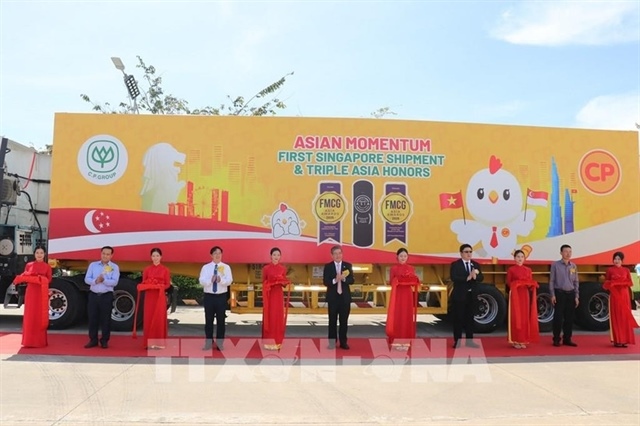Productivity key to escaping mid-income trap
Productivity key to escaping mid-income trap
Viet Nam has to focus on increasing labour productivity and overall productivity growth to avoid the risk of being stuck in the middle income trap, experts said at the Vietnam Development Forum (VDF) 2017 on Wednesday.

Prime Minister Nguyen Xuan Phuc said that there were signs of slowdown in productivity growth, a key driver of sustainable development, and this has to be reversed with innovation, creativity and technological applications.
Phuc asked government agencies, business leaders and academia to promote and implement the National Productivity Action Plan, guarding the economy against the risk of lagging behind other regional economies.
Chaired by Nguyen Chi Dung, Minister of Planning and Investment, and Ousmane Dione, World Bank Country Director for Vietnam, yesterday’s forum focused on increasing national productivity and creating leverages for sustainable development.
A key topic at the forum was productivity growth trends, including demand and supply for skilled labour and how enterprises can take advantage of technological transfers to implement structural changes that help produce more with less in fields like agriculture.
Dung also stressed the importance of productivity growth in promoting rapid and sustainable economic development.
After Viet Nam became a middle income country in 2010, it has faced new development challenges and has to ensure that it is not stuck at a certain level of growth, he added.
Dung further emphasised the decisive role played by labour productivity in economic growth, contributing about 89 per cent of GDP growth in 2017, compared to just 61.9 per cent from 2000 to 2012, said.
Acknowledging the country’s commendable growth recovery, Dione raised the question of how Viet Nam will utilise its scarce public resources efficiently to finance its development agenda over the next five years.
“Improving domestic revenue mobilisation, enhancing expenditure efficiency and debt management capacity will be crucial to achieving development objectives and creating an enabling environment for the private sector’s contribution to national productivity growth,” said Dione.
He warned that as Viet Nam’s current annual average labour productivity growth rate was at about four per cent, it was unlikely to deliver the sustained rapid growth that could see Viet Nam follow the development trajectory of countries like South Korea and Singapore.
Sustainability is a big challenge for Viet Nam, as national economic growth has been declining rapidly from 6.7 per cent in 2010 to 5.96 per cent in 2016, cautioned Nguyen Dinh Cung, Director of the Central Institute for Economic Management.
So far the Vietnamese economy has grown at a relatively high rate, but the trend is downward in the medium and long run, he commented.
According to Cung, from 2018 onwards, in order to maintain annual growth rate of about 6.8 to 7 per cent, yearly productivity growth must be kept at above 6 per cent, which leaves a gap of 1.25 percentage points with the current labour productivity rate of 4.8 per cent.
"This is a real challenge for the economy, since labour productivity has long been mainly driven by economic restructuring, while intra-industry labour productivity has tended to decrease,” Cung said.
He observed an economic composition deadlock in the transfer of resources from public sector to private sector over the past several years.
Rajah Rasiah, Senior Professor of the Asia-Europe Institute, University of Malaya, commented that Viet Nam has implemented favourable policies to develop its technological and scientific infrastructure, encourage innovation and creativity towards boosting productivity and efficiency.
However, both the government and entrepreneurs need to strengthen technical education and vocational training to global standards, Rasiah said.
Planning and Investment Minister Dung said the Government has co-ordinated with private partners, corresponding agencies and qualified experts to identify specific long-term solutions for boosting productivity, as the important growth drivers in the early stages of development, like abundant labour and natural resources, become less and less relevant, confirmed Dung.
PM Phuc said he hoped the forum would achieve concrete results in helping local government agencies understand the importance of increasing productivity, and that research organisations will propose practical solutions to the business community, based on national and international experiences.
In its fifth year, VDF 2017 aimed to analyse the current economic situation and obstacles to increasing productivity in Viet Nam. It also acted as a channel between policymakers and the business community in finding ways to achieve the 2020 socio-economic development goals.
The forum discussed major global economic trends and the challenges they pose for Viet Nam, followed by strategies to ensure sustainable development in terms of capital, labour and natural resource utilisation.
Over 300 delegates from international organisations, the private sector, ministries and agencies from different countries gathered at the 2017 VDF.
They exchanged experiences on productivity incentives and challenges, policy frameworks in favour of realising national comparative advantages and market-based institutional reforms.




















